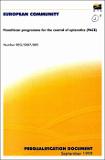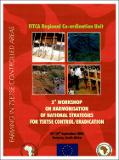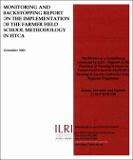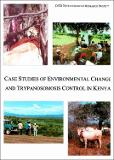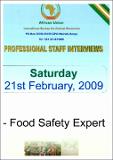AU-IBAR Initiatives and Project Reports: Recent submissions
Now showing items 201-220 of 321
-
Promotion of Livestock Farming in Tsetse Fly Infested Areas in Kenya.pdf
As in Kwale, the district can be divided into a humid coastal and dry hinterland part. Fly infestation is high and fly invasions are through (a) the bush vegetation of the surrounding districts, (b) through a gazetted ... -
PREQUALIFICATION DOCUMENT
SATEC Developpement International is a leading, independent and private French consultancy operating mainly in the field of agriculture, livestock, animal health, fishery, agro-industry, environment, rural development, and ... -
SEVETEENTH (17m) MINISTERIAL COORDINATION MEETING
The 171" Farming in Tsetse Controlled Areas (FITCA) Ministerial Coordination Meeting was held at Hotel Triangle Annexe in Jinja, Uganda between the 23rd-251" of March, 2003. It was attended by over 100 participants who ... -
WP_CE FOR SUDAN YEAR 2 OF PERIOD NOVEMBER 01 2004 TO OCTOBER 31 2006
The eradication of rinderpest from Africa is a major objective of the PACE Programme. This will be achieved by a series of co-ordinated national PACE programmes that will receive support from the PACE Programme's Epidemiology ... -
SADC Regional Livestock Sector Training Workshop on Internal Quality Control and External Quality Assurance Programmes for Veterinary Laboratories
The workshop was one of the activities of the IAEA funded SADC regional project, RAF/5/053, on Control and Eradication of major Epizootics which will run between 2001 and 2003. The overall objective of this project is to ... -
Annual Operational Review 2003 ESA Region EC Co-operation
The Cotonou Agreement attaches particular emphasis to regional economic integration and the role of regional organisations (see Art.28-30 and Annex IV, Art. 6-14). Regional organisations with an economic integration mandate ... -
OBSERVATIONS ON PACE TANZANIA EXTENSION WORK PLAN AND COST ESTIMATES FOR YEAR 1 SUBMISSION OF EXTENSION GLOBAL PLAN.
This document presents a global plan for the proposed two years extension of the Tanzania component of the Pan-African Programme for the Control of Epizootics (PACE-TZ). PACE-TZ, together with 28 other African country ... -
3rd WORKSHOP ON HARMONISATION OF NATIONAL STRATEGIES FOR TSETSE CONTROL-ERADICATION.pdf
Animal resources are important in the economic development of African countries. Africa has a wide variety of animal resources with an estimated livestock population of 224 million cattle, 447 million sheep and goats and ... -
Current Livestock Policies in Eastern and Central Africa
The paper is prepared on the basis of communications received from participants of the countries concerned as contained in their respective national reports prepared for the Seminar. Of the 26 countries invited to the ... -
Monitoring and backstopping report on the implementation of the farmer field school methodology in FITCA.
The Farmer Field School (FFS) methodology, an informal adult education approach, has been introduced in the final phases of The Farming in Tse-tse Controlled Areas Programme in Kenya, Uganda and Tanzania (7 ACP RPR 578). ... -
NATIONAL STRATEGY ON TSETSE AND TRYPANOSOMOSIS CONTROL.pdf
Tsetse-Transmitted trypanosomosis has a direct devastating effect in livestock due to increased mortality, reduced milk yield, low live weight gain, infertility, increased rate of abortion and increased susceptibility to ... -
Farming in tsetse controlled areas of Eastern Africa - Kagera FITCA Kagera.
Kagera region lies in the northwestern corner of Tanzania and is bordering Uganda in the north, Rwanda and Burundi in the west and Kigoma, Shinyanga and Mwanza regions in the south. Lake Victoria is the natural eastern ... -
REPORT OF THE TENTH COORDINATION AND EVALUATION MEETING OF THE PAN-AFRICAN CAMPAIGN AGAINST BOVINE RINDERPEST AND CONTAGIOUS PLEUROPNEUMONIA (P.A.R.C)
The opening ceremony of the Meeting was presided over by His Excellency Mr. Alassane Dialy N'DIAYE, Minister in charge of Fisheries and Maritime Transport, substituting for Mr Robert SAGNA, State Minister, Minister of ... -
Organisation of African Unity / Inter African Bureau for Animal Resources (OAU/IBAR) Farming In Tsetse Controlled Areas (FITCA - Kenya Project).
This report is based on the findings of a survey carried out for FITCA-K by Kamau Kabbucho of Fineline Systems & Management Limited. The survey was commissioned to identify strategies and mechanisms by which FITCA-K could ... -
SOMALI PACE PROJECT - Contract No. PACE-EDF-TN-001-01
The Somali PACE Component operates under the overall PACE objective aiming at improving farmers' incomes and peoples' general living conditions by strengthening livestock services and hence improve and maintain animal ... -
Farming in Tsetse Controlled Area (Kenya) Project 7 ACP KE 087-7 ACP RPR 578.pdf
Farming in Tsetse Controlled Area (Kenya) Project 7 ACP KE 087-7 ACP RPR 578.pdf -
Case studies of environmental change and trypanosomosis control in Kenya.
The human population of east Africa is very unevenly distributed across the region and, as can be seen in Figure 1, is concentrated around Lake Victoria, in the highlands, and along the coast. The conjectural limits of ... -
FARMING IN TSETSE CONTROL AREAS PROGRAMME (FITCA) MID-TERM REVIEW
This study is the mid term review of the FITCA (Farming in tsetse controlled areas) Programme. This review is commissioned as planned in the FITCA Financing agreement. It has however been slightly delayed to take into ... -
FINANCIAL PROCEDURES
The Fourth ACP-EEC Convention (LOME IV), Article 221(g) states that: "Development finance cooperation shall: (g) be carried out with a minimum of administrative formalities using simple and rational procedures so that ... -
Vacancy Announcement: FOOD SAFETY EXPERT [PROFESSIONAL STAFF INTERVIEWS]
On behalf of PAN-SPSO, AU/IBAR seeks the services of a <I>food safety officer</i> to support the activity of the Project coordination unit. POST LEVEL: P3, step 5 (USD 4,629.61 local, USD 5,592.39 international recruitment) TYPE: ...

